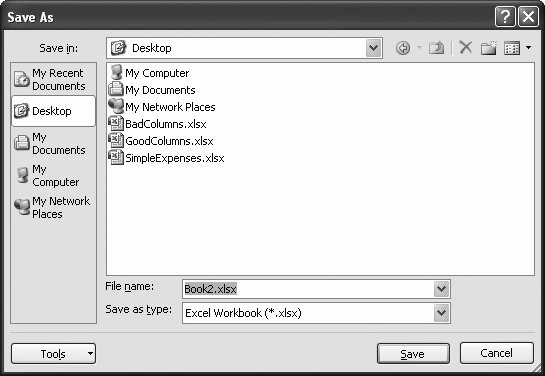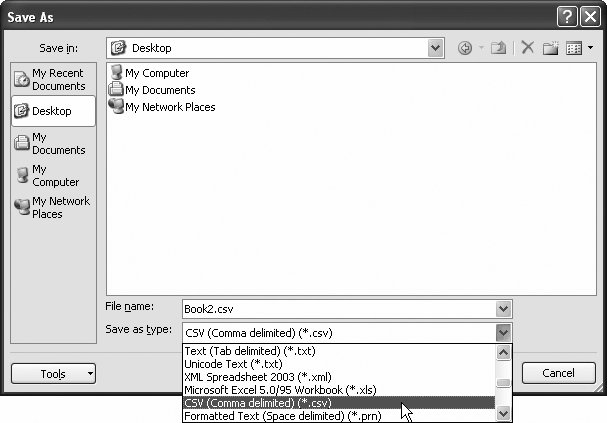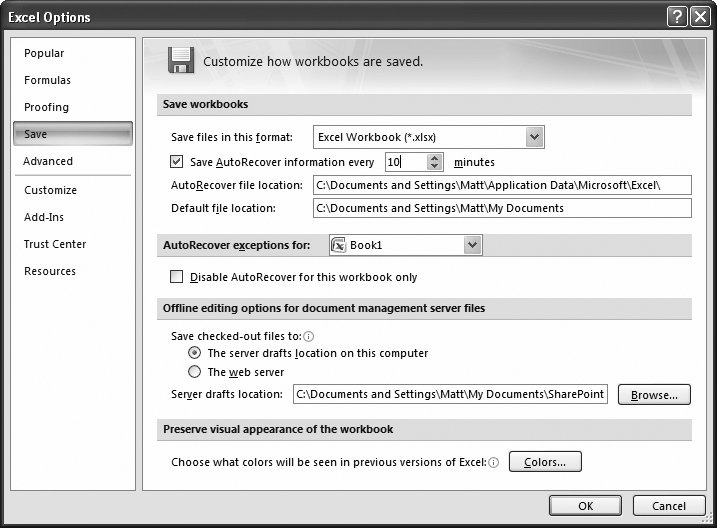1.4. Saving Files As everyone who's been alive for at least three days knows , you should save your work early and often. Excel is no exception. You have two choices for saving a spreadsheet file: -
Save As . This choice allows you to save your spreadsheet file with a new name. You can use Save As the first time you save a new spreadsheet, or you can use it to save a copy of your current spreadsheet with a new name , in a new folder, or as a different file type. (Alternate file formats are discussed in Section 1.4.2.) To use Save As, select Office button  Save As, or press F12. Figure 1-15 shows you the Save As dialog box as it appears on a Windows XP computer. (The Windows Vista version of the Save As dialog box has all the same features, but way more style.) Save As, or press F12. Figure 1-15 shows you the Save As dialog box as it appears on a Windows XP computer. (The Windows Vista version of the Save As dialog box has all the same features, but way more style.)  | Figure 1-15. The Save As dialog box lets you jump to common folders using the big buttons on the left, or you can browse a folder tree using the drop-down "Save in" menu. Once you've found the folder you want, type the file name at the bottom of the window, and then pick the file type. Finally, click Save to finish the job. | |
-
Save . This option updates the spreadsheet file with your most recent changes. If you use Save on a new file that hasn't been saved before, it has the same effect as Save As: Excel prompts you to choose a folder and file name. To use Save, select Office button  Save, or press Ctrl+S. Or, look up at the top of the Excel window in the Quick Access toolbar for the tiny Save button, which looks like an old-style diskette. Save, or press Ctrl+S. Or, look up at the top of the Excel window in the Quick Access toolbar for the tiny Save button, which looks like an old-style diskette.
Tip: Resaving a spreadsheet is an almost instantaneous operation, and you should get used to doing it all the time. After you've made any significant change, just hit Ctrl+S to make sure you've stored the latest version of your data.
1.4.1. The Excel 2007 File Format Since time immemorial, Excel fans have been saving their lovingly crafted spreadsheets in .xls files (as in AirlineSilverware.xls). Excel 2007 changes all that. In fact, it introduces a completely new file format, with the extension . xlsx (as in Airline-Silverware.xlsx). At first glance, this seems a tad over the top. But the new file format has some real advantages: -
It's compact . The new Excel file format uses Zip file compression, so spreadsheet files are smallerway smaller (as much as 75 percent smaller than their original sizes). And even though the average hard drive is already large enough to swallow thousands of old-fashioned Excel files, the new compact format is easier to email around. -
It's less error-prone . The new file format carefully separates ordinary content, pictures, and macro code into separate sections. (Macros are automated routines that perform a specific task in a spreadsheet.) Microsoft claims that this change makes for tougher files. Now, if a part of your Excel file is damaged (for example, due to a faulty hard drive), there's a much better chance that you can still retrieve the rest of the information. (You'll learn about Excel disaster recovery in Section 1.4.4.) -
It's extensible . The new file format uses XML (the eXtensible Markup Language), which is a standardized way to store information. XML storage doesn't benefit the average person, but it's sure to earn a lot of love from companies that plan to build custom software that uses Excel documents. As long as Excel documents are stored in XML, these companies can create automated programs that pull the information they need straight out of a spreadsheet, without going through Excel. These programs can also generate made-to-measure Excel documents all on their own. For all these reasons, .xlsx is the format of choice for Excel 2007. However, Microsoft prefers to give people all the choices they could ever need (rather than make life really simple), and Excel file formats are no exception. Along with the standard .xlsx, there's the closely related .xls m cousin, which adds the ability to store macro code. If you've added any macros to your spreadsheet, Excel prompts you to use this file type when you save your spreadsheet. 1.4.2. Saving Your Spreadsheet in Older Formats Most of the time, you don't need to think about Excel's file formatyou can just create your spreadsheets, save them, and let Excel take care of the rest. The only time you need to stop and think twice is when you need to share your work with other, less fortunate people who have older versions of Excel. When you find yourself in this situation, you have two choices: -
Save your spreadsheet in the old format . You can save a copy of your spreadsheet in the traditional .xls Excel standard that's been supported since Excel 97. To do so, choose Office button  Save As Save As  Excel 97-2003 Format. Excel 97-2003 Format. -
Use a free add-in for older versions of Excel . People who are stuck with Excel 2000, Excel 2002, or Excel 2003 can read your Excel 2007 filesthey just need a free add-in that's provided by Microsoft. This is a good solution because it's doesn't require any work on your part. People with past-its-prime versions of Excel can find the add-in they need by surfing to www.microsoft.com/downloads and searching for "compatibility pack file formats" (or use the secret shortcut URL http://tinyurl.com/y5w78r). Often, the best thing you can do is keep your spreadsheet in the newer format and save a copy in the older format (using Office button  Save As Save As  Excel 97-2003 Format). You can then hand that copy out to your backward friends . Excel 97-2003 Format). You can then hand that copy out to your backward friends . Some eccentric individuals have even older or stranger spreadsheet software on their computers. If you want to save a copy of your spreadsheet in a more exotic file type, you can choose Office button  Save As, and then find the desired format in the "Save as type drop-down list (Figure 1-16). Excel lets you save your spreadsheet using a variety of different formats, including the classic Excel 95 format from a decade ago. If you're looking to view your spreadsheet using a mystery program, use the CSV file type, which produces a comma-delimited text file that almost all spreadsheet applications on any operating system can read (comma-delimited means the information has commas separating each cell ). Save As, and then find the desired format in the "Save as type drop-down list (Figure 1-16). Excel lets you save your spreadsheet using a variety of different formats, including the classic Excel 95 format from a decade ago. If you're looking to view your spreadsheet using a mystery program, use the CSV file type, which produces a comma-delimited text file that almost all spreadsheet applications on any operating system can read (comma-delimited means the information has commas separating each cell ).  | Figure 1-16. Excel offers a few useful file type options in the "Save as type" list. CSV format is the best choice for compatibility with truly old software (or when nothing else seems to work). If you're a longtime Excel fan, you'll notice that the list has been slimmed down a bitfor example, there's no option to use the old dBase and Lotus formats from the DOS world. | |
Tip: When you save your Excel spreadsheet in another format, make sure you keep a copy in the standard .xlsx format. Why bother? Because other formats aren't guaranteed to retain all your information, particularly if you choose a format that doesn't support some of Excel's newer features.
1.4.3. Saving Your Spreadsheet As a PDF Sometimes you want to save a copy of your spreadsheet so that people can read it even if they don't have Excel (and even if they're running a different operating system, like Linux or Apple's OS X). In this situation, you have several choices: -
Use the Excel Viewer . Even if you don't have Excel, you can install a separate tool called the Excel Viewer, which is available from Microsoft's Web site (search for "Excel Viewer" at www.microsoft.com/downloads). However, few people have the viewer, and even though it's free, few want to bother installing it. And it doesn't work on non-Windows computers. -
Save your workbook as an HTML Web page . That way, all you need to view the workbook is a Web browser (and who doesn't have one of those?). The only disadvantage is that you could lose complex formatting. Some worksheets may make the transition to HTML gracefully, while others don't look very good when they're squashed into a browser window. And if you're planning to let other people print the exported worksheet, the results might be unsatisfactory. -
Save your workbook as a PDF file . This gets you the best of both worldsyou keep all the rich formatting (so your workbook can be printed), and you let people who don't have Excel (and possibly don't even have Windows) view your workbook. The only disadvantage is that this feature isn't included in the basic Excel package. Instead, you need to install a free add-in to get it. To get the Save As PDF add-in, surf to www.microsoft.com/downloads and search for "PDF." The links lead you to a page where you can download the add-in and install it with just a couple of clicks. Once you install the Save As PDF add-in, all your Office applications have the ability to save their documents in PDF format. In Excel, you work this magic by choosing Office button  Save As Save As  PDF, which brings up the "Publish as PDF dialog box (Figure 1-17). PDF, which brings up the "Publish as PDF dialog box (Figure 1-17). When you save a PDF file, you get a few extra options in the Save As dialog box. PDF files can be saved with different resolution and quality settings (which mostly affect any graphical objects that you've placed in your workbook, like pictures and charts ).  | Figure 1-17. The "Publish as PDF" dialog box looks a lot like the Save As dialog box, except it has a Publish button instead of a Save button. You can switch on the "Open file after publishing" setting to tell Excel to open the PDF file in Adobe Reader ( assuming you have it installed) after the publishing process is complete, so you can check the result. | |
Normally, you use higher quality settings if you're planning to print your PDF file, because printers use higher resolutions than computer monitors . The "Publish as PDF" dialog box gives you some control over the quality settings with the "Optimize for" options. If you're just saving a PDF copy so other people can view the information in your workbook, choose "Minimum size (publishing online)" to save some space. On the other hand, if there's a possibility that the people reading your PDF might want to print it out, choose "Standard (publishing online and printing)" to save a slightly larger PDF that makes for a better printout. Finally, if you want to publish only a portion of your spreadsheet as a PDF file, click the Options button to open a dialog box with even more settings. You can choose to publish just a fixed number of pages, just the selected cells , and so on. These options mirror the choices you get when sending a spreadsheet to the printer. You also see a few more cryptic options, most of which you can safely ignore. (They're intended for PDF nerds.) One exception is the "Document properties" optionturn this off if you don't want the PDF to keep track of certain information that identifies you, like your name.
Tip: Getting the Save As PDF add-in is a bit of a hassle, but it's well worth the effort. In previous versions of Excel, people who wanted to create PDFs file had to get another add-in or buy the expensive full version of the Adobe Acrobat software. The Save As PDF feature was originally slated for inclusion in Excel (with no add-in required), but anti-trust concerns caused ultra -cautious Microsoft to leave it out.
1.4.4. Disaster Recovery The corollary to the edict "Save your data early and often" is the truism "Sometimes things fall apart quickly before you've even had a chance to back up." Fortunately, Excel includes an invaluable safety net called AutoRecover. AutoRecover periodically saves backup copies of your spreadsheet while you work. If you suffer a system crash, you can retrieve the last AutoRecover backup even if you never managed to save the file yourself. Of course, even the AutoRecover backup won't necessarily have all the information you entered in your spreadsheet before the problem occurred. But if AutoRecover saves a backup every 10 minutes (the standard), at most you'll lose 10 minutes of work. AutoRecover comes switched on when you install Excel, but you can tweak its settings. Select Office  Excel Options, and then choose the Save section. Under the "Save workbooks section, make sure that "Save AutoRecover information" is turned on. You can also make a few other changes to AutoRecover settings: Excel Options, and then choose the Save section. Under the "Save workbooks section, make sure that "Save AutoRecover information" is turned on. You can also make a few other changes to AutoRecover settings: -
You can also adjust the backup frequency in minutes. Figure 1-18 has some tips on timing. -
You can choose the folder where you'd like Excel to save backup files. (The standard folder works fine for most people, but feel free to pick some other place.) Unfortunately, there's no handy Browse button to help you find the folder, so you need to find the folder you want in advance (using a tool like Windows Explorer), write it down somewhere, and then copy the full folder path into this dialog box. -
Under the "AutoRecover exceptions" heading, you can tell Excel not to bother saving a backup of a specific spreadsheet. Pick the spreadsheet name from the list (which shows all the currently open spreadsheet files), and then turn on the "Disable AutoRecover for this workbook only" setting. This setting is exceedingly uncommon, but you might use it if you have a gargantuan spreadsheet full of data that doesn't need to be backed up.  | Figure 1-18. You can configure how often AutoRecover saves backups . There's really no danger in being too frequent. Unless you work with extremely complex or large spreadsheetswhich might suck up a lot of computing power and take a long time to saveyou can set Excel to save the document every five minutes with no appreciable slowdown . | |
If your computer does crash, when you get it running again, you can easily retrieve your last AutoRecover backup. In fact, the next time you launch Excel, it automatically checks the backup folder, and, if it finds a backup, it opens a Document Recovery panel on the left of the Excel window. If your computer crashes in mid-edit, the next time you open Excel you'll probably see the same file listed twice in the Document Recovery window, as shown in Figure 1-19. The difference is the status. The status [AutoSaved] indicates the most recent backup created by Excel. The status [Original] indicates the last version of the file that you saved (which is safely stored on your hard drive, right where you expect it).  | Figure 1-19. You can save or open an AutoRecover backup just as you would an ordinary Excel file; simply click the item in the list. Once you've dealt with all the backup files, close the Document Recovery window by clicking the Close button. If you haven't saved your backup, Excel asks you at this point whether you want to save it permanently or delete the backup. | |
To open a file that's in the Document Recovery window, just click it. You can also use a drop-down menu with additional options (Figure 1-19). Make sure you save the file before you leave Excel. After all, it's just a temporary backup. If you attempt to open a backup file that's somehow been scrambled (technically known as corrupted ), Excel automatically attempts to repair it. You can choose Show Repairs to display a list of any changes Excel had to make to recover the file. |
 Save As, or press F12. Figure 1-15 shows you the Save As dialog box as it appears on a Windows XP computer. (The Windows Vista version of the Save As dialog box has all the same features, but way more style.)
Save As, or press F12. Figure 1-15 shows you the Save As dialog box as it appears on a Windows XP computer. (The Windows Vista version of the Save As dialog box has all the same features, but way more style.) 



